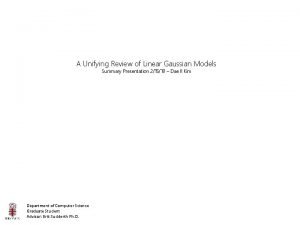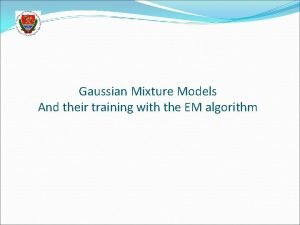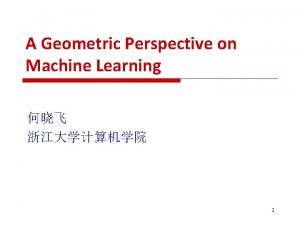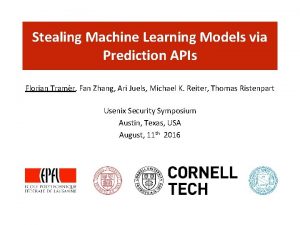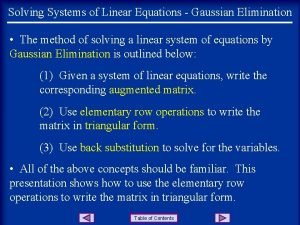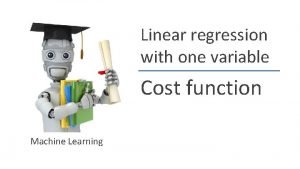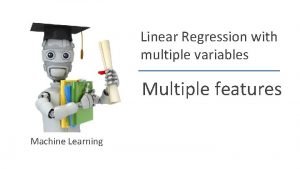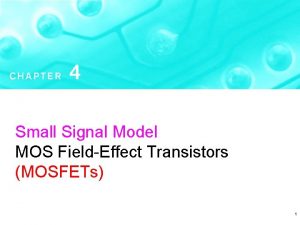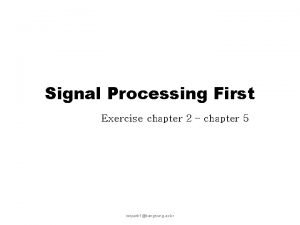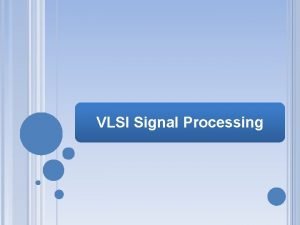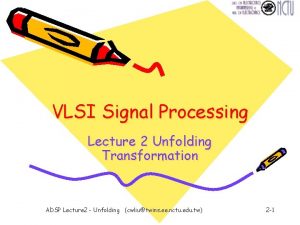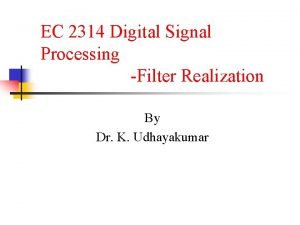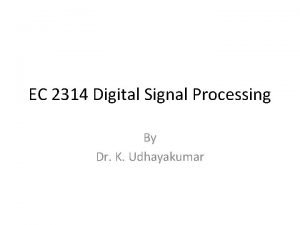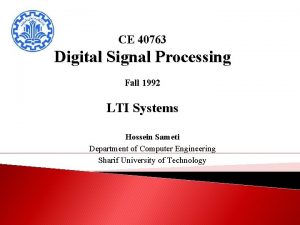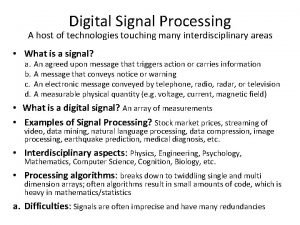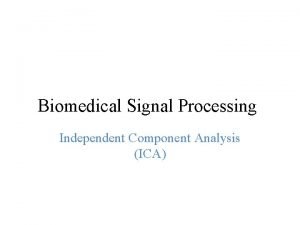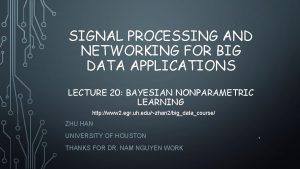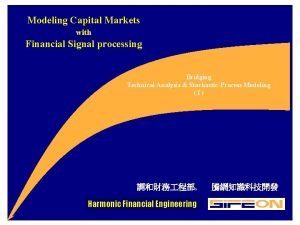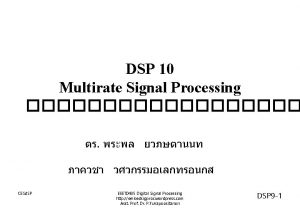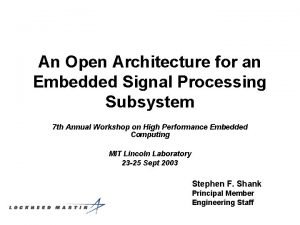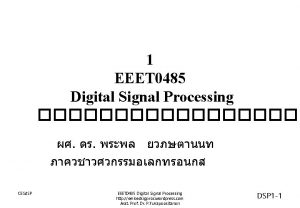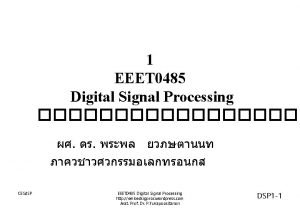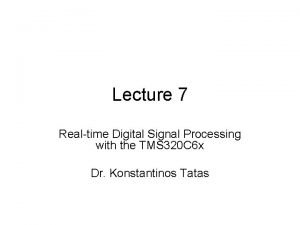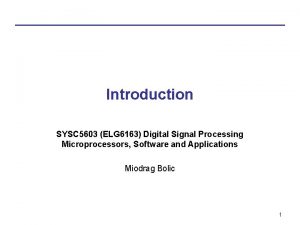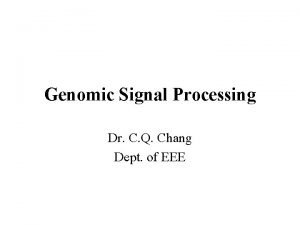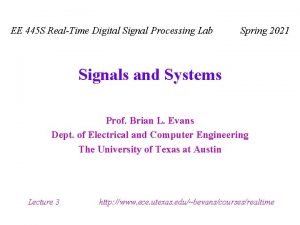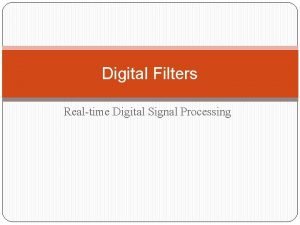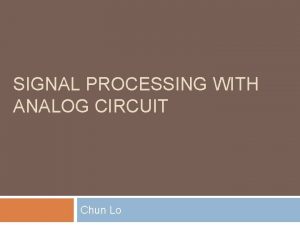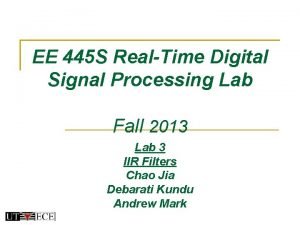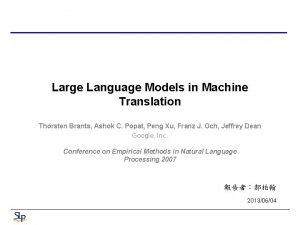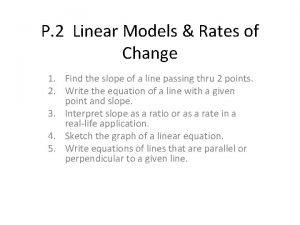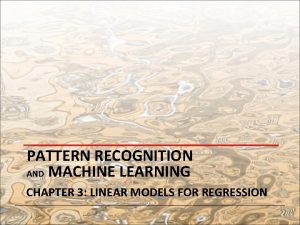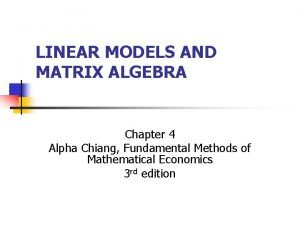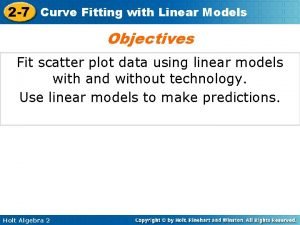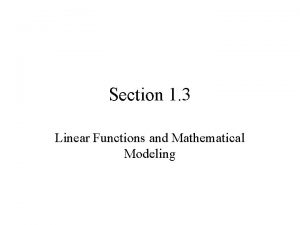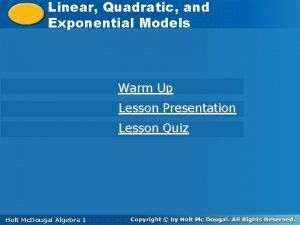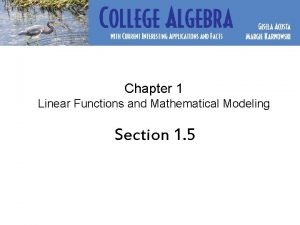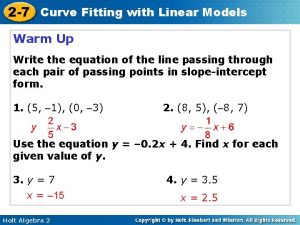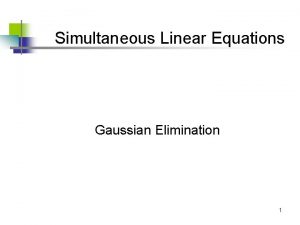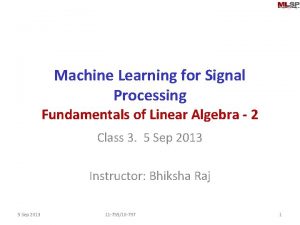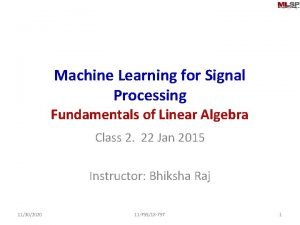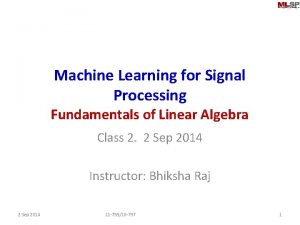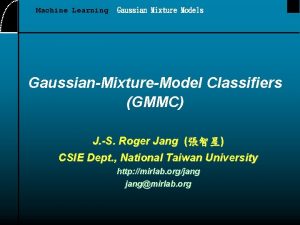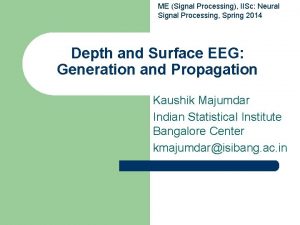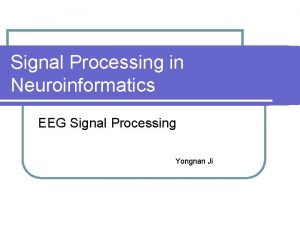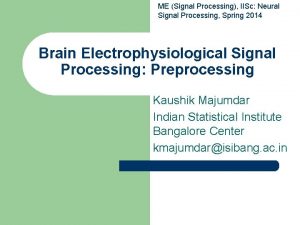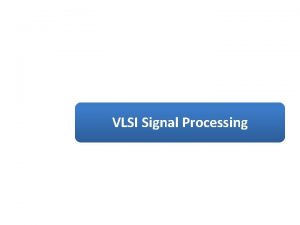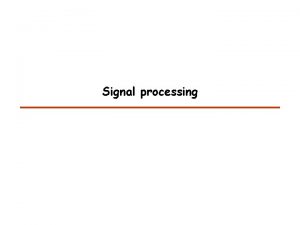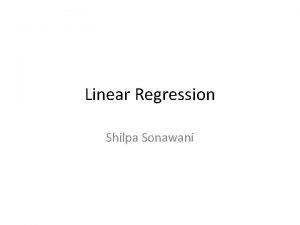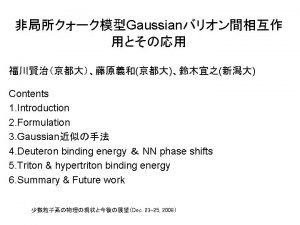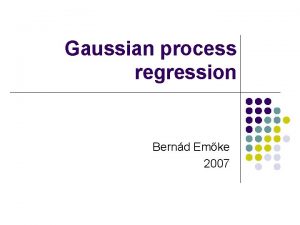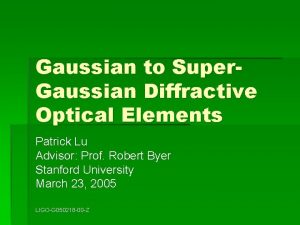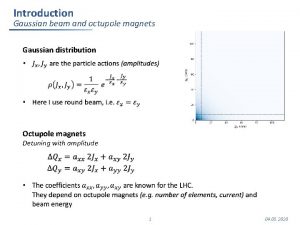Machine Learning for Signal Processing Linear Gaussian Models






































































- Slides: 70

Machine Learning for Signal Processing Linear Gaussian Models Class 17. 30 Oct 2014 Instructor: Bhiksha Raj 11755/18797 1

Recap: MAP Estimators • MAP (Maximum A Posteriori): Find a “best guess” for y (statistically), given known x y = argmax Y P(Y|x) 11755/18797 2

Recap: MAP estimation • x and y are jointly Gaussian • z is Gaussian 11755/18797 3

MAP estimation: Gaussian PDF F 1 Y X 11755/18797 4

MAP estimation: The Gaussian at a particular value of X x 0 11755/18797 5

Conditional Probability of y|x • The conditional probability of y given x is also Gaussian – The slice in the figure is Gaussian • The mean of this Gaussian is a function of x • The variance of y reduces if x is known – Uncertainty is reduced 11755/18797 6

MAP estimation: The Gaussian at a particular value of X Most likely value F 1 x 0 11755/18797 7

MAP Estimation of a Gaussian RV x 0 11755/18797 8

Its also a minimum-mean-squared error estimate • Minimize error: • Differentiating and equating to 0: The MMSE estimate is the mean of the distribution 11755/18797 9

For the Gaussian: MAP = MMSE Most likely value is also The MEAN value § Would be true of any symmetric distribution 11755/18797 10

A Likelihood Perspective = + • y is a noisy reading of a. Tx • Error e is Gaussian • Estimate A from 11755/18797 19

The Likelihood of the data • Probability of observing a specific y, given x, for a particular matrix a • Probability of collection: • Assuming IID for convenience (not necessary) 11755/18797 20

A Maximum Likelihood Estimate • Maximizing the log probability is identical to minimizing the least squared error 11755/18797 21

A problem with regressions • ML fit is sensitive – Error is squared – Small variations in data large variations in weights – Outliers affect it adversely • Unstable – If dimension of X >= no. of instances • (XXT) is not invertible 11755/18797 22

MAP estimation of weights a y=a. TX+e X e • Assume weights drawn from a Gaussian – P(a) = N(0, s 2 I) • Max. Likelihood estimate • Maximum a posteriori estimate 11755/18797 23

MAP estimation of weights q q P(a) = N(0, s 2 I) Log P(a) = C – log s – 0. 5 s-2 ||a||2 • Similar to ML estimate with an additional term 11755/18797 24

MAP estimate of weights • Equivalent to diagonal loading of correlation matrix – Improves condition number of correlation matrix • Can be inverted with greater stability – Will not affect the estimation from well-conditioned data – Also called Tikhonov Regularization • Dual form: Ridge regression • MAP estimate of weights – Not to be confused with MAP estimate of Y 11755/18797 25

MAP estimate priors • Left: Gaussian Prior on W • Right: Laplacian Prior 11755/18797 26

MAP estimation of weights with laplacian prior • Assume weights drawn from a Laplacian – P(a) = l-1 exp(-l-1|a|1) • Maximum a posteriori estimate • No closed form solution – Quadratic programming solution required • Non-trivial 11755/18797 27

MAP estimation of weights with laplacian prior • Assume weights drawn from a Laplacian – P(a) = l-1 exp(-l-1|a|1) • Maximum a posteriori estimate –… • Identical to L 1 regularized least-squares estimation 11755/18797 28

L 1 -regularized LSE • No closed form solution – Quadratic programming solutions required • Dual formulation subject to • “LASSO” – Least absolute shrinkage and selection operator 11755/18797 29

LASSO Algorithms • Various convex optimization algorithms • LARS: Least angle regression • Pathwise coordinate descent. . • Matlab code available from web 11755/18797 30

Regularized least squares Image Credit: Tibshirani • Regularization results in selection of suboptimal (in least-squares sense) solution – One of the loci outside center • Tikhonov regularization selects shortest solution • L 1 regularization selects sparsest solution 11755/18797 31

LASSO and Compressive Sensing Y = X a • Given Y and X, estimate sparse W • LASSO: – X = explanatory variable – Y = dependent variable – a = weights of regression • CS: – X = measurement matrix – Y = measurement – a = data 11755/18797 32

MAP / ML / MMSE • General statistical estimators • All used to predict a variable, based on other parameters related to it. . • Most common assumption: Data are Gaussian, all RVs are Gaussian – Other probability densities may also be used. . • For Gaussians relationships are linear as we saw. . 11755/18797 33

Gaussians and more Gaussians. . • Linear Gaussian Models. . • But first a recap 11755/18797 34

A Brief Recap • Principal component analysis: Find the K bases that best explain the given data • Find B and C such that the difference between D and BC is minimum – While constraining that the columns of B are orthonormal 11755/18797 35

Remember Eigenfaces • Approximate every face f as f = wf, 1 V 1+ wf, 2 V 2 + wf, 3 V 3 +. . + wf, k Vk • Estimate V to minimize the squared error • Error is unexplained by V 1. . Vk • Error is orthogonal to Eigenfaces 11755/18797 36

Karhunen Loeve vs. PCA • Eigenvectors of the Correlation matrix: – Principal directions of tightest ellipse centered on origin – Directions that retain maximum energy 11755/18797 37

Karhunen Loeve vs. PCA • Eigenvectors of the Correlation matrix: • Eigenvectors of the Covariance matrix: – Principal directions of tightest ellipse centered on origin – Directions that retain maximum energy 11755/18797 – Principal directions of tightest ellipse centered on data – Directions that retain maximum variance 38

Karhunen Loeve vs. PCA M RA T E OR F S N V N NE U RH E LO KA • Eigenvectors of the Correlation matrix: • Eigenvectors of the Covariance matrix: – Principal directions of tightest ellipse centered on origin – Directions that retain maximum energy 11755/18797 – Principal directions of tightest ellipse centered on data – Directions that retain maximum variance 39

Karhunen Loeve vs. PCA O SF Pr inc RM om AN R ET V OE L EN UN H R KA • Eigenvectors of the Correlation matrix: ipa l. C po ne nt An aly sis • Eigenvectors of the Covariance matrix: – Principal directions of tightest ellipse centered on origin – Directions that retain maximum energy 11755/18797 – Principal directions of tightest ellipse centered on data – Directions that retain maximum variance 40

Karhunen Loeve vs. PCA • If the data are naturally centered at origin, KLT == PCA • Following slides refer to PCA! – Assume data centered at origin for simplicity • Not essential, as we will see. . 11755/18797 41

Remember Eigenfaces • Approximate every face f as f = wf, 1 V 1+ wf, 2 V 2 + wf, 3 V 3 +. . + wf, k Vk • Estimate V to minimize the squared error • Error is unexplained by V 1. . Vk • Error is orthogonal to Eigenfaces 11755/18797 42

Eigen Representation = w 11 0 w 11 + e 1 Illustration assuming 3 D space • K-dimensional representation – Error is orthogonal to representation – Weight and error are specific to data instance 11755/18797 43

Representation Error is at 90 o to the eigenface 90 o w 12 = w 12 + e 2 Illustration assuming 3 D space • K-dimensional representation – Error is orthogonal to representation – Weight and error are specific to data instance 11755/18797 44

Representation All data with the same representation w. V 1 lie a plane orthogonal to w. V 1 0 w • K-dimensional representation – Error is orthogonal to representation 11755/18797 45

With 2 bases Error is at 90 o to the eigenfaces = w 11 + w 21 + e 1 0, 0 w 11 e 1 w 21 Illustration assuming 3 D space • K-dimensional representation – Error is orthogonal to representation – Weight and error are specific to data instance 11755/18797 46

With 2 bases = w 12 Error is at 90 o to the eigenfaces w 22 + e 2 w 12 e 2 Illustration assuming 3 D space • K-dimensional representation – Error is orthogonal to representation – Weight and error are specific to data instance 11755/18797 47

In Vector Form Xi = w 1 i. V 1 + w 2 i. V 2 + ei Error is at 90 o to the eigenfaces V 2 w 22 w 12 e 2 D 2 V 1 • K-dimensional representation – Error is orthogonal to representation – Weight and error are specific to data instance 11755/18797 48

In Vector Form Xi = w 1 i. V 1 + w 2 i. V 2 + ei Error is at 90 o to the eigenface V 2 • • • w 22 w 12 e 2 D 2 V 1 K-dimensional representation x is a D dimensional vector V is a D x K matrix w is a K dimensional vector e is a D dimensional vector 11755/18797 49

Learning PCA • For the given data: find the K-dimensional subspace such that it captures most of the variance in the data – Variance in remaining subspace is minimal 11755/18797 50

Constraints Error is at 90 o to the eigenface V 2 w 22 w 12 e 2 D 2 V 1 • VTV = I : Eigen vectors are orthogonal to each other • For every vector, error is orthogonal to Eigen vectors – e. T V = 0 • Over the collection of data – Average ww. T = Diagonal : Eigen representations are uncorrelated – Determinant e. Te = minimum: Error variance is minimum • Mean of error is 0 11755/18797 51

A Statistical Formulation of PCA Error is at 90 o to the eigenface V 2 w 22 w 12 e 2 D 2 V 1 • x is a random variable generated according to a linear relation • w is drawn from an K-dimensional Gaussian with diagonal covariance • e is drawn from a 0 -mean (D-K)-rank D-dimensional Gaussian • Estimate V (and B) given examples of x 11755/18797 52

Linear Gaussian Models!! • x is a random variable generated according to a linear relation • w is drawn from a Gaussian • e is drawn from a 0 -mean Gaussian • Estimate V given examples of x – In the process also estimate 11755/18797 B and E 53

Linear Gaussian Models!! a G ar n a i uss e n i l a f o e c n a t s n i c i f r i c a l e u p c s i t a r s a i p A h t C i P w l e d s t o l n i a m a n • x is satrandom variable generated according to a linear relation r o g on = Dia I c • w is drawn = a Gaussian B VTfrom k V n a • • r w • e is drawn from a 0 -mean Gaussian o l s i EV given examples of x • Estimate • – In the process also estimate 11755/18797 B and E 54

Linear Gaussian Models • Observations are linear functions of two uncorrelated Gaussian random variables – A “weight” variable w – An “error” variable e – Error not correlated to weight: E[e. Tw] = 0 • Learning LGMs: Estimate parameters of the model given instances of x – The problem of learning the distribution of a Gaussian RV 11755/18797 55

LGMs: Probability Density • The mean of x: • The Covariance of x: 11755/18797 56

The probability of x • x is a linear function of Gaussians: x is also Gaussian • Its mean and variance are as given 11755/18797 57

Estimating the variables of the model • Estimating the variables of the LGM is equivalent to estimating P(x) – The variables are m, V, B and E 11755/18797 58

Estimating the model • The model is indeterminate: – Vw = VCC-1 w = (VC)(C-1 w) – We need extra constraints to make the solution unique • Usual constraint : B = I – Variance of w is an identity matrix 11755/18797 59

Estimating the variables of the model • Estimating the variables of the LGM is equivalent to estimating P(x) – The variables are m, V, and E 11755/18797 60

The Maximum Likelihood Estimate • Given training set x 1, x 2, . . x. N, find m, V, E • The ML estimate of m does not depend on the covariance of the Gaussian 11755/18797 61

Centered Data • We can safely assume “centered” data –m=0 • If the data are not centered, “center” it – Estimate mean of data • Which is the maximum likelihood estimate – Subtract it from the data 11755/18797 62

Simplified Model • Estimating the variables of the LGM is equivalent to estimating P(x) – The variables are V, and E 11755/18797 63

Estimating the model • Given a collection of xi terms – x 1, x 2, . . x. N • Estimate V and E • w is unknown for each x • But if assume we know w for each x, then what do we get: 11755/18797 64

Estimating the Parameters • We will use a maximum-likelihood estimate • The log-likelihood of x 1. . x. N knowing their wis 11755/18797 65

Maximizing the log-likelihood • Differentiating w. r. t. V and setting to 0 • Differentiating w. r. t. E-1 and setting to 0 11755/18797 66

Estimating LGMs: If we know w • But in reality we don’t know the w for each x – So how to deal with this? • EM. . 11755/18797 67

Recall EM Instance from blue dice Instance from red dice 6 Dice unknown 6 6 6 . . Collection of “blue” Collection of “red” numbers 6 . . Collection of “blue” Collection of “red” numbers • We figured out how to compute parameters if we knew the missing information • Then we “fragmented” the observations according to the posterior probability P(z|x) and counted as usual • In effect we took the expectation with respect to the a posteriori probability of the missing data: P(z|x) 11755/18797 68

EM for LGMs • Replace unseen data terms with expectations taken w. r. t. P(w|xi) 11755/18797 69

EM for LGMs • Replace unseen data terms with expectations taken w. r. t. P(w|xi) 11755/18797 70

Expected Value of w given x • x and w are jointly Gaussian! – x is Gaussian – w is Gaussian – They are linearly related 11755/18797 71

Expected Value of w given x • x and w are jointly Gaussian! 11755/18797 72

The conditional expectation of w given z • P(w|z) is a Gaussian 11755/18797 73

LGM: The complete EM algorithm • Initialize V and E • E step: • M step: • 11755/18797 74

So what have we achieved • Employed a complicated EM algorithm to learn a Gaussian PDF for a variable x • What have we gained? ? ? • Next class: – PCA • Sensible PCA • EM algorithms for PCA – Factor Analysis • FA for feature extraction 11755/18797 75

LGMs : Application 1 Learning principal components • Find directions that capture most of the variation in the data • Error is orthogonal to these variations 11755/18797 76

LGMs : Application 2 Learning with insufficient data FULL COV FIGURE • The full covariance matrix of a Gaussian has D 2 terms • Fully captures the relationships between variables • Problem: Needs a lot of data to estimate robustly 11755/18797 77

To be continued. . • Other applications. . • Next class 11755/18797 78
 A unifying review of linear gaussian models
A unifying review of linear gaussian models Training gaussian mixture models at scale via coresets
Training gaussian mixture models at scale via coresets Type of machine learning models
Type of machine learning models Geometric models in machine learning
Geometric models in machine learning Inversion attacks
Inversion attacks Stealing machine learning models via prediction apis
Stealing machine learning models via prediction apis метод гаусса
метод гаусса Cost function linear regression
Cost function linear regression Linear regression with multiple variables machine learning
Linear regression with multiple variables machine learning Linear regression with multiple variables machine learning
Linear regression with multiple variables machine learning Concept learning task in machine learning
Concept learning task in machine learning Analytical learning in machine learning
Analytical learning in machine learning Pac learning model in machine learning
Pac learning model in machine learning Machine learning t mitchell
Machine learning t mitchell Inductive and analytical learning in machine learning
Inductive and analytical learning in machine learning Deductive learning vs inductive learning
Deductive learning vs inductive learning Instance based learning in machine learning
Instance based learning in machine learning Inductive learning machine learning
Inductive learning machine learning First order rule learning in machine learning
First order rule learning in machine learning Lazy vs eager learning
Lazy vs eager learning Deep learning vs machine learning
Deep learning vs machine learning Baseband signal and bandpass signal
Baseband signal and bandpass signal Baseband signal and bandpass signal
Baseband signal and bandpass signal Digital signal as a composite analog signal
Digital signal as a composite analog signal Product of two odd signal is
Product of two odd signal is How to draw small signal equivalent circuit mosfet
How to draw small signal equivalent circuit mosfet Modal and semi modal verbs
Modal and semi modal verbs Cuadro comparativo de e-learning
Cuadro comparativo de e-learning Signal processing first
Signal processing first Vl
Vl Unfolding in vlsi signal processing
Unfolding in vlsi signal processing Ladder structure realization of iir filter
Ladder structure realization of iir filter Digital signal processing
Digital signal processing Dr sujan ali
Dr sujan ali Digital signal processing
Digital signal processing Signal processing toolbox matlab
Signal processing toolbox matlab Complex wave
Complex wave Ica signal processing
Ica signal processing Signal processing for big data
Signal processing for big data Financial signal processing
Financial signal processing Digital signal processing
Digital signal processing Digital signal processing
Digital signal processing Open architecture radar
Open architecture radar Digital signal processing
Digital signal processing Digital signal processing
Digital signal processing Digital signal processing
Digital signal processing Sysc 2004 course outline
Sysc 2004 course outline Genomic signal processing
Genomic signal processing Digital signal processing
Digital signal processing Z transform
Z transform Signal processing filter
Signal processing filter Signal processing solutions
Signal processing solutions High-performance digital signal processing
High-performance digital signal processing Precision analog signal processing
Precision analog signal processing Digital signal processing
Digital signal processing Image compression in digital image processing
Image compression in digital image processing 4-fold evacuating litters
4-fold evacuating litters Thorsten brants
Thorsten brants Linear and transactional communication
Linear and transactional communication The hunkins model
The hunkins model Linear models and rates of change
Linear models and rates of change Berlo's model of communication advantages and disadvantages
Berlo's model of communication advantages and disadvantages Linear basis function models
Linear basis function models Linear models and matrix algebra
Linear models and matrix algebra Flair furniture company linear programming
Flair furniture company linear programming Curve fitting with linear models
Curve fitting with linear models Linear functions as mathematical models
Linear functions as mathematical models How to tell if a graph is linear quadratic or exponential
How to tell if a graph is linear quadratic or exponential Linear functions as mathematical models
Linear functions as mathematical models Curve fitting with linear models
Curve fitting with linear models Top-down vs bottom-up processing
Top-down vs bottom-up processing
